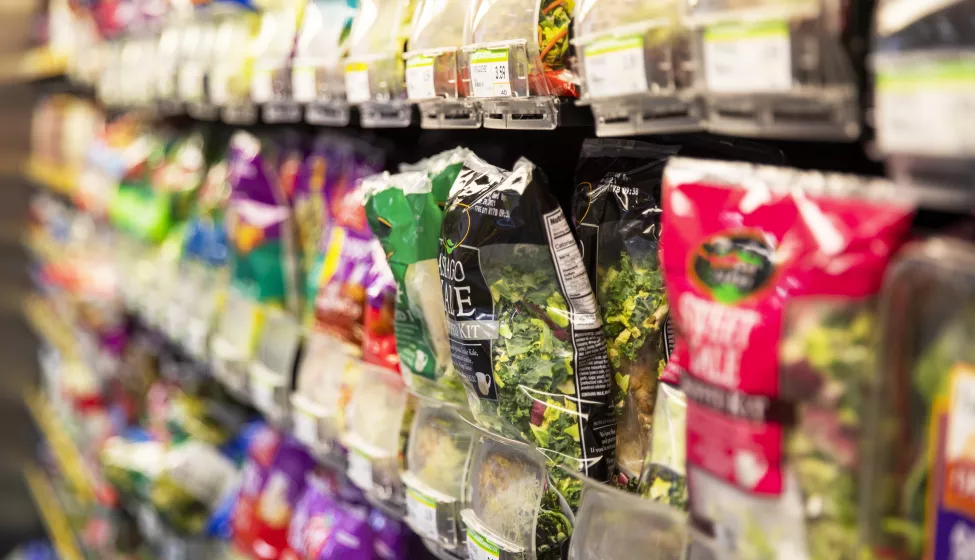November 30, 2023
A two-pronged incident response strategy for food manufacturers in the wake of prominent recalls
After a wave of high-profile food recalls, U.S. food manufacturers may be considering whether their internal and external response mechanisms are ready in the event of an incident related to the discovery of unwanted objects in their products.
Over the past several months, leading grocers and food manufacturers have recalled ready-to-eat products due to issues such as plastic pieces found in microwaveable chicken strips and insects and rocks in canned goods and grocery house brands.
This type of contamination — the introduction of unwanted foreign materials — can inflict reputational damage through persistent media attention, and the problem, which can encompass materials such as plastics, metal, and glass, could also be growing. According to a third-party study of Food and Drug Administration actions, food recalls spiked by 700 percent from 2021 to 2022, with foreign material contamination increasing as well. The U.S. Department of Agriculture, which regulates meat, poultry, and processed egg products, has also listed foreign material contamination as the leading cause of food recalls in 2022 by unit count.
For manufacturers, there's no room for guesswork when responding to the discovery of a foreign material in your food product and determining whether it's a risk to consumers or your brand.
Sharpening an incident response strategy
For manufacturers, there's no room for guesswork when responding to the discovery of a foreign material in your food product and determining whether it's a risk to consumers or your brand. To manage potential contamination, a two-pronged strategy can support companies in acting quickly and responsibly. First, identify the scope and scale of the hazard presented by the foreign material; second, identify actions to resolve the root cause of the foreign material and prevent future incidents.
Withdraw or recall? Defining and communicating food safety incidents to regulatory agencies and the public
In the event of a foreign material contamination incident, determining the degree of potential harm to the public will be a top priority to immediately limit potential safety impacts to consumers. This determination will include characterization of foreign materials by frequency of occurrence, size, shape, sharpness, and hardness, as well as performing a health hazard evaluation (HHE). The HHE includes considering what consumer demographic the product is intended for, how the food is prepared and consumed, and how that impacts the degree of risk.
An internal team or independent third party can help to rapidly evaluate whether the contamination presents as a hazard that crosses the threshold of adulteration by FDA's definition, therefore requiring a product recall, or if it can simply be withdrawn from the market, requiring no notification of the agency. FDA would deem a product adulterated if "Hard or sharp foreign objects in food may cause traumatic injury including laceration and perforation of tissues of the mouth, tongue, throat, stomach and intestine as well as damage to the teeth and gums." If a product is rendered potentially injurious to consumers, a recall to remove it from the market will be required to avoid being in violation of the law.
Additionally, FDA provides guidance to industry on how to interpret potential risks to consumers from foreign materials based on size thresholds determined from studies of consumer injuries. Materials under 25 mm will likely have the greatest potential to cause harm, while FDA notes that "hard and sharp objects smaller than 7 mm (0.28)" rarely cause injury except in certain high-risk groups such as infants, surgery patients, and the elderly.
Aside from size and shape, additional information can help food manufacturers understand potential health risks to consumers, the need and scope of a recall, as well as determining the root cause so that corrective actions may be taken:
• What was the source of the foreign material?
• When and where did the foreign material enter the production stream?
• What is the foreign material (i.e., glass, wood, metal, plastic, organic material, etc.)?
• At what frequency is the foreign material present in the food? Who are the intended users of the finished food product? Do they include sensitive subpopulations?
• How noticeable would the foreign material be in the food?
• Have there been consumer complaints or adverse event reports?
If the HHE of the food product indicates there is the potential for harm to consumers and immediate action to recall the product is warranted, brand owners or food manufacturers will need to consider how to communicate the information quickly and effectively to regulatory agencies, suppliers, and downstream business customers. In many cases communications will also need to include the public to minimize harm. While most recalls are voluntary and self-initiated, they can also be requested by FDA or mandated under statutory authority. FDA classifies recalls based on their relative health risk.
The most severe type of recall, Class I, indicates the potential for serious injury or death and requires FDA notification within 24 hours after confirming that a foreign material is present in a food product that has already been released into interstate commerce. Class II recalls have a lower chance of causing major injuries. A Class III recall is for affected food products that violate FDA regulations or the Federal Food, Drug, and Cosmetic Act but are unlikely to cause adverse health consequences.
All recalls require FDA notification along with a plan to recoup the affected product and destroy it. Importantly, a root-cause investigation should be initiated if the contamination source is not already known.
In lieu of a recall, a company may determine that the identified issue is only a minor deviation from product specifications, involves no violation of the Food Drug and Cosmetic Act, and would not be subject to enforcement action by FDA. In this case, the company may undertake a market withdrawal that does not require FDA notification. This typically occurs when a product has an out-of-specification quality deviation, enabling the company to either remove the product from shelves or correct the violation. Market withdrawals do not require FDA notification since the withdrawal itself is based on an internal specification that would not be subject to any regulatory action.

Determining root causes, assessing responsibility, and safeguarding food manufacturing
To terminate a recall, regulatory agencies will require verification and documentation that the brand owner or food manufacturer has revalidated the process and is fully complying with Hazard Analysis Risk-Based Preventive Controls (HARPC). This typically means identifying what the foreign material is and reassessing the potential for future foreign material hazards through a post-incident, in-plant assessment that offers a full understanding of the entry points where foreign materials were introduced into the supply chain, the manufacturer's facilities, equipment, utensils, personnel, and processes. This is typically followed by retraining frontline workers on new preventive measures.
Analyzing the type and source of foreign materials is not only critical to controlling an incident or potential recall but can also help prevent it from happening again. Foreign materials found in packaged foods can result in litigation, particularly when the material is glass, so understanding the risks of various manufacturing materials (both common and newly developing) can help drive appropriate measures of response and communication. Analytical characterization of foreign materials can also be conducted using a multitude of techniques and well-designed protocols.
To shield a company's reputation and address liability, a crucial aspect of a root-cause investigation is determining whether the foreign material contamination occurred in the processing plant, upstream (suppliers), or downstream (distribution, retailers, food processors, or even the consumer's home).
Often, foreign material incidents can originate with poor maintenance practices. A lack of routine preventive maintenance can allow metal shards, plastic from conveyors, and rubber gasket pieces to enter the food production line as equipment ages. Internal daily and monthly preventive maintenance and inspections, as well as outside third-party audits, can help identify these potential issues before they present a problem. Maintenance activities to address equipment issues can also contribute to contamination if appropriate controls for repairs and routine cleaning are not implemented.
In contrast, as new equipment, new ingredients, and new suppliers enter the food production line, brand owners and food manufacturers should be equally ready to change standard operating procedures that specify how both maintenance and production workers will carry out operations to ensure food safety. New equipment may introduce foreign material and other issues if introduced without proper safety review. For instance, new scrapers, whisks, or spatulas from a different supplier may react differently to heat and chemical processes on the production line.
Food packaging materials can also be a source of contamination introduced during production, such as glass or metal particles in bottling lines. Sourcing and handling of packaging materials should involve safeguards against the introduction of foreign material. Intake of packaging should also be well managed to ensure that fragments of food wrappers and liners do not enter the ingredients when decanting raw materials.
Preventing future incidents of foreign material contamination
Of course, the best time to uncover food safety hazards is before they result in product contamination. While the risk of foreign material contamination can never be fully eliminated, coming as close as possible to contaminant free is the best way to prioritize consumer safety and protect a company's reputation.
As media coverage of food contaminants remains a decisive factor in consumer selection, actionable, science-based recommendations can help food manufacturers both prevent and respond to the continuous reality of potential foreign material contaminants.
What Can We Help You Solve?
Exponent helps food manufacturers investigate contamination events, identify the source and composition of the material, navigate supply chain traceback, and implement corrective and preventive actions. We can conduct on-site gap assessments of food manufacturing facilities, including mock inspections, and we offer support across regulatory and litigation matters.








![Consumer Products [PSMC]](/sites/default/files/styles/cards_home_card/public/media/images/GettyImages-171366863.jpg.webp?itok=0YQ9vN1U)


